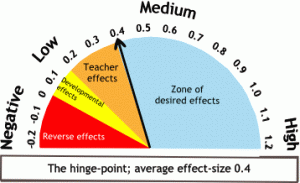This is post number four in a ten part blog series (you may click here to start from the beginning).
This blog series serves to highlight the most significant findings from John Hattie’s 2012 work, Visible Learning for Teachers: Maximizing Impact on Learning and their applications to our classrooms. His work has given educators quantifiable insights that have no parallel in the field of education.
Need an introduction or a crash course on the effect sizes referenced below? An effect size of 0.40 is what Hattie refers to as a hinge-point regarding what is significantly effective or at “a level where the effects of innovation enhance achievement in such a way that we can notice real-world differences” (Hattie, 2009). Anything between a 0.00 and 0.39 is growth, but is not considered significant growth. Anything below a 0.00 is considered detrimental to student growth.
Number 7 – Classroom Discussion (effect size = 0.82)
Classroom discussion is another critical area of Hattie’s study with a huge effect size. Classroom discussions provide the opportunity for students to communicate with one another for a variety of functions including to activate prior knowledge, to explore new topics, to learn from others, and to demonstrate their learning. This is an engagement strategy which provides all students the chance to participate, especially when structured in a way that extends beyond a teacher-student question and answer sequence. 
Application to the Classroom
Consider what Hattie’s website, visiblelearning.org, asserts regarding what your most effective classrooms discussions should include:
- creating a series of questions for the students to think about
- allocating enough time in the lesson for an elaborate discussion
- making sure that students can freely express their opinion without being laughed at or ridiculed
You can click here for a concise, yet detailed, paper by William E. Cashin on how to effectively plan, moderate, and reflect on classroom discussions. His advice includes the following recommendations for fostering participation (which he expands upon in the writing):
- Ask general (divergent) questions.
- Avoid looking only at the student talking.
- Control excessive talkers.
- Ask for examples and illustrations.
- Be sensitive to feelings and emotional reactions.
- Encourage and recognize students’ contributions.
A Random Mention
Number 45 out of 150 – Socioeconomic Status (effect size 0.52)
Socioeconomic status does have a significant impact on student achievement. Factors such as parental income, parental education, and parental occupation play a role in how their children perform. Studies cite that SES is pronounced in the early years of schooling where students from lower SES groups started school having spoken about 2.5 million words versus those from higher groups having spoken 4.5 million words, as Hattie cited in a Hart and Risley study from 1995. Hattie suggest that the “language” of school (i.e. cultural norms parents of lower SES are not familiar with) make learning difficult for those with from a lower SES group and the barriers are created because of this difficulty.
A Peek at the Bottom 10
Number 147 out of 150 – Home Welfare Policies (effect size -0.12)
Hattie cited that there is close to zero effects from students who received welfare compared to those not receiving welfare. He shares that there are certainly effects of welfare programs that are beneficial to families, “but it seems that there are other more powerful effects on achievement than the welfare status of the family” (2009, p. 64).
For more from this blog series view the following posts:
#8 – Comprehensive Interventions for Learning Disabled Students
Hattie, J., Visible Learning: A Synthesis of Over 800 Meta-Analyses Relating to Achievement (2009)
Hattie, J. Visible Learning for Teachers: Maximizing Impact on Learning (2012)
Visible Learning, http://visible-learning.org/glossary/#7_Classroom_discussion
Cashin Paper: http://ideaedu.org/wp-content/uploads/2014/11/IDEA_Paper_49.pdf
Effect size image retrieved from: http://www.learningandteaching.info/teaching/what_works.htm
Discussion image retrieved from: http://www.global-english.com/news/tips-for-tefl-discussion-classes/





February 25, 2016 at 5:17 pm
Outstanding blog series Brian! Taking what we know and distilling it into how and why we can and must is essential.
ML
February 25, 2016 at 6:27 pm
Thanks for reading, Mike!